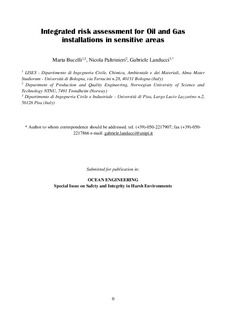| dc.contributor.author | Bucelli, Marta | |
| dc.contributor.author | Paltrinieri, Nicola | |
| dc.contributor.author | Landucci, Gabriele | |
| dc.date.accessioned | 2019-02-20T08:55:07Z | |
| dc.date.available | 2019-02-20T08:55:07Z | |
| dc.date.created | 2018-01-23T09:18:27Z | |
| dc.date.issued | 2018 | |
| dc.identifier.citation | Ocean Engineering. 2018, 150 377-390. | nb_NO |
| dc.identifier.issn | 0029-8018 | |
| dc.identifier.uri | http://hdl.handle.net/11250/2586426 | |
| dc.description.abstract | Oil and gas installations in sensitive areas with harsh environmental conditions may require improved risk management. Intensified monitoring, assessment and mitigation of risk on a (quasi-) real time basis would advantage not only the operators, but also the surrounding environment. A systematic tool for continuous quantitative evaluation of safety and environmental issues is still lacking. The present work introduces a novel methodology for the integrated assessment of human and environmental risk. A dynamic perspective is adopted to systematically consider the performance of safety barriers. Environmental risk is further investigated by using the risk matrix approach, which evaluates both frequency and severity of oil spill. The methodology is applied to the case of a real oil platform in the Barents Sea. A set of simulations on how the platform is conducted demonstrated that the proposed method may be suitable for risk analysis in such critical conditions. It also showed that dynamic risk assessment may allow identifying critical safety barrier elements, whose correct performance needs to be prioritized to control risk. This is also supported by environmental risk assessment, showing that further safety measures may be considered for biological and environmental conservation. | nb_NO |
| dc.language.iso | eng | nb_NO |
| dc.publisher | Elsevier | nb_NO |
| dc.rights | Attribution-NonCommercial-NoDerivatives 4.0 Internasjonal | * |
| dc.rights.uri | http://creativecommons.org/licenses/by-nc-nd/4.0/deed.no | * |
| dc.title | Integrated risk assessment for oil and gas installations in sensitive areas | nb_NO |
| dc.type | Journal article | nb_NO |
| dc.type | Peer reviewed | nb_NO |
| dc.description.version | acceptedVersion | nb_NO |
| dc.source.pagenumber | 377-390 | nb_NO |
| dc.source.volume | 150 | nb_NO |
| dc.source.journal | Ocean Engineering | nb_NO |
| dc.identifier.doi | 10.1016/j.oceaneng.2017.12.035 | |
| dc.identifier.cristin | 1549612 | |
| dc.description.localcode | © 2018. This is the authors’ accepted and refereed manuscript to the article. Locked until 21.12.2019 due to copyright restrictions. This manuscript version is made available under the CC-BY-NC-ND 4.0 license http://creativecommons.org/licenses/by-nc-nd/4.0/ | nb_NO |
| cristin.unitcode | 194,64,92,0 | |
| cristin.unitname | Institutt for maskinteknikk og produksjon | |
| cristin.ispublished | true | |
| cristin.fulltext | postprint | |
| cristin.qualitycode | 1 | |

